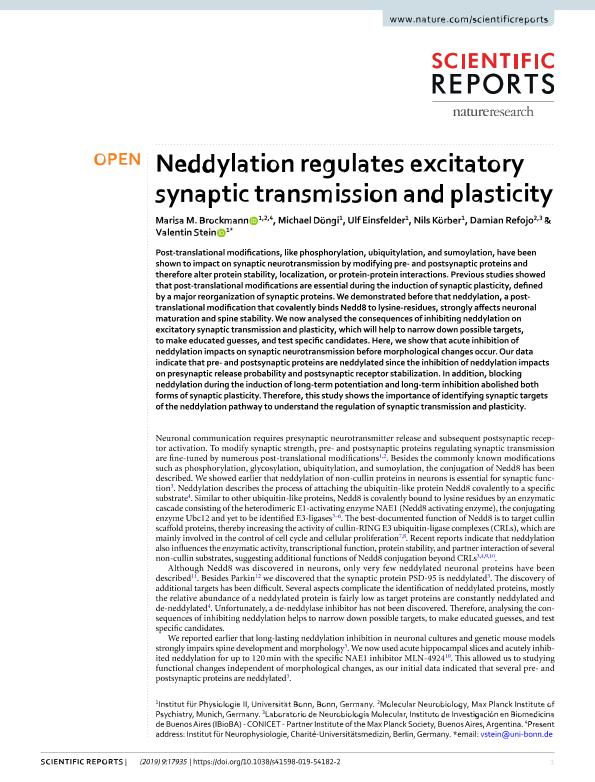Mostrar el registro sencillo del ítem
dc.contributor.author
Brockmann, Marisa M.
dc.contributor.author
Döngi, Michael
dc.contributor.author
Einsfelder, Ulf
dc.contributor.author
Körber, Nils
dc.contributor.author
Refojo, Damian

dc.contributor.author
Stein, Valentin
dc.date.available
2021-02-03T11:47:25Z
dc.date.issued
2019-11
dc.identifier.citation
Brockmann, Marisa M.; Döngi, Michael; Einsfelder, Ulf; Körber, Nils; Refojo, Damian; et al.; Neddylation regulates excitatory synaptic transmission and plasticity; Nature Publishing Group; Scientific Reports; 9; 1; 11-2019; 1-10
dc.identifier.issn
2045-2322
dc.identifier.uri
http://hdl.handle.net/11336/124562
dc.description.abstract
Post-translational modifications, like phosphorylation, ubiquitylation, and sumoylation, have been shown to impact on synaptic neurotransmission by modifying pre- and postsynaptic proteins and therefore alter protein stability, localization, or protein-protein interactions. Previous studies showed that post-translational modifications are essential during the induction of synaptic plasticity, defined by a major reorganization of synaptic proteins. We demonstrated before that neddylation, a post-translational modification that covalently binds Nedd8 to lysine-residues, strongly affects neuronal maturation and spine stability. We now analysed the consequences of inhibiting neddylation on excitatory synaptic transmission and plasticity, which will help to narrow down possible targets, to make educated guesses, and test specific candidates. Here, we show that acute inhibition of neddylation impacts on synaptic neurotransmission before morphological changes occur. Our data indicate that pre- and postsynaptic proteins are neddylated since the inhibition of neddylation impacts on presynaptic release probability and postsynaptic receptor stabilization. In addition, blocking neddylation during the induction of long-term potentiation and long-term inhibition abolished both forms of synaptic plasticity. Therefore, this study shows the importance of identifying synaptic targets of the neddylation pathway to understand the regulation of synaptic transmission and plasticity.
dc.format
application/pdf
dc.language.iso
eng
dc.publisher
Nature Publishing Group

dc.rights
info:eu-repo/semantics/openAccess
dc.rights.uri
https://creativecommons.org/licenses/by-nc-sa/2.5/ar/
dc.subject
Nedd8
dc.subject
plasticity
dc.subject
neuron
dc.subject.classification
Neurociencias

dc.subject.classification
Medicina Básica

dc.subject.classification
CIENCIAS MÉDICAS Y DE LA SALUD

dc.title
Neddylation regulates excitatory synaptic transmission and plasticity
dc.type
info:eu-repo/semantics/article
dc.type
info:ar-repo/semantics/artículo
dc.type
info:eu-repo/semantics/publishedVersion
dc.date.updated
2020-11-20T19:54:15Z
dc.journal.volume
9
dc.journal.number
1
dc.journal.pagination
1-10
dc.journal.pais
Reino Unido

dc.description.fil
Fil: Brockmann, Marisa M.. Universitat Bonn; Alemania. Max Planck Institute Of Psychiatry; Alemania
dc.description.fil
Fil: Döngi, Michael. Universitat Bonn; Alemania
dc.description.fil
Fil: Einsfelder, Ulf. Universitat Bonn; Alemania
dc.description.fil
Fil: Körber, Nils. Universitat Bonn; Alemania
dc.description.fil
Fil: Refojo, Damian. Consejo Nacional de Investigaciones Científicas y Técnicas. Oficina de Coordinación Administrativa Parque Centenario. Instituto de Investigación en Biomedicina de Buenos Aires - Instituto Partner de la Sociedad Max Planck; Argentina
dc.description.fil
Fil: Stein, Valentin. Universitat Bonn; Alemania
dc.journal.title
Scientific Reports
dc.relation.alternativeid
info:eu-repo/semantics/altIdentifier/doi/https://doi.org/10.1038/s41598-019-54182-2
dc.relation.alternativeid
info:eu-repo/semantics/altIdentifier/url/https://www.nature.com/articles/s41598-019-54182-2
Archivos asociados
